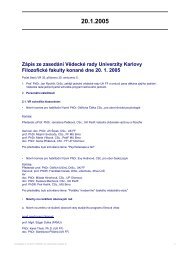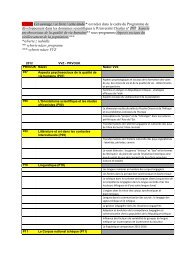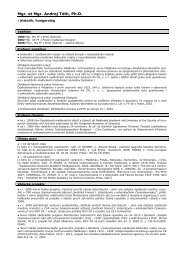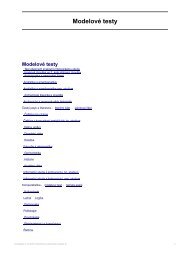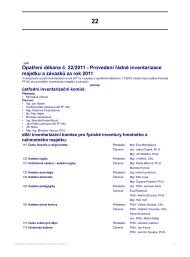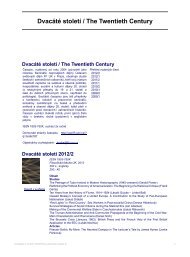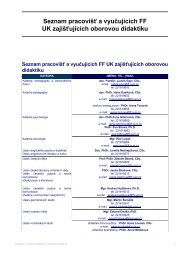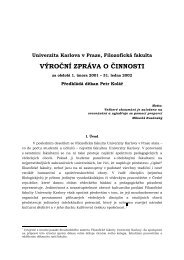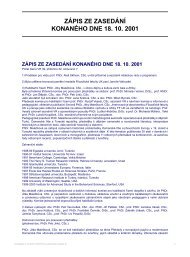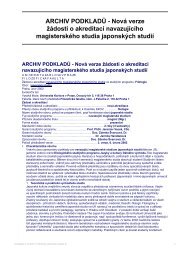Dear Students, This guide is intended particularly for you ...
Dear Students, This guide is intended particularly for you ...
Dear Students, This guide is intended particularly for you ...
Create successful ePaper yourself
Turn your PDF publications into a flip-book with our unique Google optimized e-Paper software.
postcards and posters. The exhibit goes<br />
on to show the aspects of daily life under<br />
commun<strong>is</strong>m, from propaganda at schools<br />
and work to empty shelves in stores, as<br />
the theme turns from ideal<strong>is</strong>tic dream<br />
to horrific reality. However, by far the<br />
most intense experience <strong>is</strong> watching the<br />
30-minute or so film near the end of the<br />
exhibition. The video presents clips from<br />
the Warsaw Pact invasion of 1968 and<br />
the Velvet Revolution of 1989. After half an hour of watching people of all ages and<br />
sexes brutally beaten by riot police on camera, suddenly <strong>you</strong>r own life won’t seem so<br />
bad. Open Monday to Sunday, 8 am – 9 pm.<br />
Náprstek Museum of Asian, African and American Cultures,<br />
Address: Betlémské náměstí 1<br />
In 1826 the Fingerhut family bought the old Prague building “U Halánků” with a brewery<br />
and d<strong>is</strong>tillery which, within a matter of years, their older son Vojtěch was to make<br />
famous literally throughout the whole world. In 1848, after the overthrow of revolution<br />
in Vienna and Prague, Vojta Náprstek (1826 – 1894) sought refuge from police persecution<br />
<strong>for</strong> ten years in the United States, where he gained a lot of experience. Upon h<strong>is</strong><br />
return to the country, he tried to use th<strong>is</strong> knowledge to repay the Czech society. One<br />
of h<strong>is</strong> most important activities was the construction of the private Czech Industrial<br />
Museum, which was supposed to help underdeveloped Czech manufacturing. Be<strong>for</strong>e<br />
long, the museum and library became the centre of the Czech intellectual scene, and,<br />
thanks to Náprstek’s contacts among Czechs living outside the country, was even celebrated<br />
abroad. Apart from exhibits on things technical, the museum also accumulated<br />
ethnographic and art<strong>is</strong>tic artefacts, which Náprstek’s friends and travellers brought from<br />
all around the world. After h<strong>is</strong> death the museum became ethnographic, and after 1946<br />
its bearing was orientated purely towards non-European cultures.<br />
Top Coins and Fine Art,<br />
Address: Klimentská 6<br />
Top Coins and Fine Art presents an introduction to Australian Aboriginal Art. The gallery<br />
features examples of the several different styles of Aboriginal Art with work by<br />
over 100 different art<strong>is</strong>ts from all over the “Top End” of Australia, with many works<br />
by art<strong>is</strong>ts of the Central Western Desert of the Northern Territory Arnhem Land and<br />
the Tiwi Islands.<br />
DOX Centre <strong>for</strong> Contemporary Art<br />
Address: Poupětova 1, Praha 7 http://www.doxprague.org/en/<br />
Brand new modern art musem The DOX Centre was initiated in 2002 by Leoš Válka,<br />
along with several partners. The goal of th<strong>is</strong> initiative <strong>is</strong> to serve the wider public by<br />
creating a living arts centre, becoming a plat<strong>for</strong>m <strong>for</strong> the exhibition of Czech and<br />
international contemporary art.<br />
Museum Kampa,<br />
Address: U sovových mlýnů 2<br />
While the earliest surviving records mentioning<br />
the ex<strong>is</strong>tence of a flour-mill on<br />
Prague’s Kampa <strong>is</strong>land on the Vltava dates<br />
from 1393, there <strong>is</strong> no doubt that the facility<br />
had actually been establ<strong>is</strong>hed much<br />
earlier than that: scholarly research has traced it as far back as the tenth century, establ<strong>is</strong>hed<br />
by members of the Convent of Benedictine Nuns at Saint George’s. During the<br />
Hussite Revolution the mill was destroyed, and the prem<strong>is</strong>es subsequently passed into<br />
the hands of the municipality of the Prague Old Town. In 1478, the city fathers handed<br />
the site over to Václav Sova of Liboslav, who built a house with a hammer-mill and a<br />
flourmill. The restored mill was named after its new owner, a name it has retained to<br />
th<strong>is</strong> day (Sovovy mlýny). The old building now hosts a modern art gallery with a permanent<br />
collection of modern Central European art and many attractive exhibitions.<br />
Museum of Modern and Contemporary Art<br />
Address: Dukelských Hrdinů 47<br />
Kinský Palace<br />
Address: Staroměstské náměstí 12<br />
Museum of Decorative Arts<br />
Address: 17. l<strong>is</strong>topadu 2<br />
The Museum of Decorative Arts in Prague collects and preserves examples of h<strong>is</strong>torical<br />
and contemporary crafts, as well as applied arts and design.<br />
80 81




